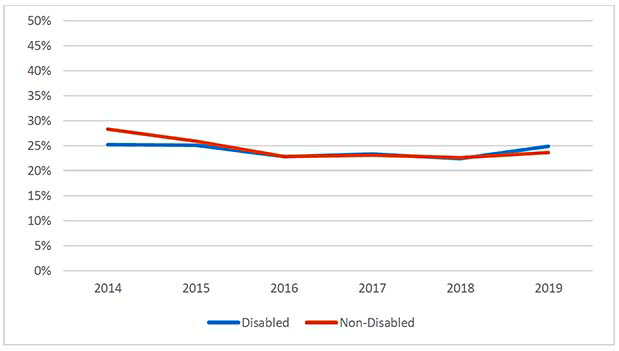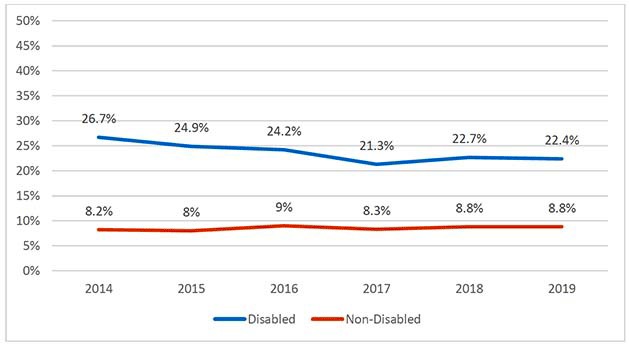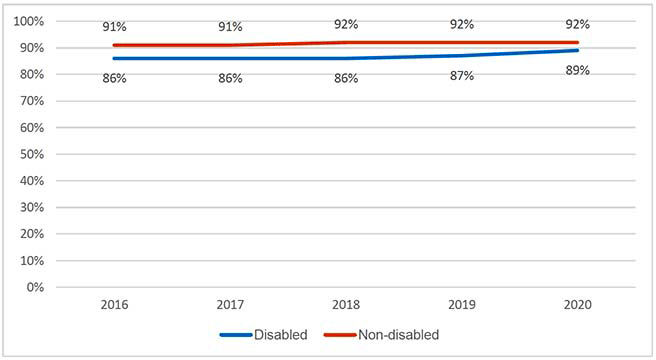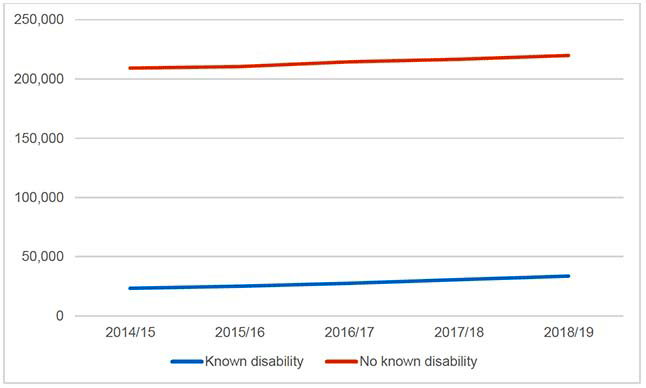National Performance Framework - disability perspective: analysis
Analysis which compares the outcomes and experiences of disabled people to those of non-disabled people using indicators drawn from Scotland’s National Performance Framework (NPF).
5. Education
National Outcome: We are well educated, skilled and able to contribute to society
There are nine indicators for Education in the National Performance Framework. At present four indicators do not have defined measurements, and two are not individual level measurements. Updated data is available for the remaining three indicators:
Work Place Learning (Pre COVID-19 Data)
Figure 7, below, demonstrates that in 2014 there was a statistically significant difference in the proportion of disabled and non-disabled people in employment receiving job-related training (25% of disabled people vs 28% of non-disabled people). From 2015-19 there was no difference in the proportion of disabled and non-disabled people in employment receiving job-related training.

Source: Annual Population Survey, 2014-2019, ONS
Skill Profile of the Population (Pre COVID-19 Data)
Figure 8, below, demonstrates the proportion of disabled people with low or no qualifications decreased between 2014 and 2019. In 2019, 22.4% of disabled people had low or no qualifications, a significant reduction of 4 percentage points since 2014 when 26.7% of disabled people were in this situation. However, the proportion of non-disabled people with low or no qualifications was significantly lower than the proportion for disabled people across all time points.

Source: Annual Population Survey, 2014-2019, ONS
Young People's Participation (Pre COVID-19 Data)
This indicator measures the number of people aged 16-19 who are not in education, employment or training (NEET). This is calculated using the Annual Participation Measure for 16-19 year olds, published by Skills Development Scotland (SDS).[29] In 2020, just under nine in ten (89%) of disabled young people were in education, employment and training, compared to just over nine in ten (92%) of non-disabled young people. Figure 9, below, demonstrates that there has been little change in participation rates amongst disabled and non-disabled young people in the period 2016-2020.[30][31]

Sources: Annual Participation Measure for 16-19 year olds in Scotland 2018 and 2020
Additional Indicators
School leaver destinations (Pre COVID-19 Data)
When the outcomes for school leavers from publicly funded secondary schools are measured, 93% of those assessed as or declared disabled school leavers in 2018/19 went on to positive destinations, including work, training or further study. This is lower than the 95% of non-disabled school leavers.[32]
The percentage of non-disabled students leaving for higher education[33] was double the number of disabled students (41% compared to 20%). However, the proportion of those leaving for further education was substantially higher among disabled people relative to non-disabled people (46% compared to 27%).[34]
For the whole of the UK, the overall number of disabled students has increased year on year. The main reason for this increase is students identified as having a mental health condition. Of students with a 'known disability' in 2018/19 the category of 'specific learning difficulty' was the largest group, accounting for over a third (36%) of the total.[35]
At Scottish Higher Education providers, participation in Higher Education by disabled people increased from 2014/15 to 2018/19 (see figure 10). In 2014/15 there were 23,330 disabled students enrolled in Scottish Higher Education providers, and this number had risen to 33,595 by 2018/19.[36] The overall percentage of disabled students in the student body increased from 10% in 2014/15 to 13% in 2018/19.

Source: Higher Education Student Statistics: UK, 2018/19 - Student numbers and characteristics
Contact
There is a problem
Thanks for your feedback